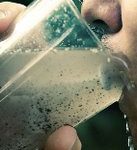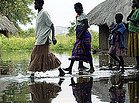In 2007 about two million people were affected by a massive algal bloom that spread across Taihu, or Tai Lake, in eastern China. The government earmarked 100 million yuan (US$14.6 million) to clean it up.
The residents of Wuxi city, which straddles the lake, have a vivid memory of that hellish summer. Gallons and gallons of pollution from farms and factories – and even human sewage – had been pouring into the lake and triggered the giant bloom of blue-green algae. Drinking water turned green and fetid. The main source was fertilisers from farms. Billions of yuan have been spent to try to clean up the lake so far.
After the nightmare of 2007, was the lake any cleaner in 2008? Greenpeace went to investigate.
We were sad but not surprised to find that the lake was still smothered in algal blooms. In fact, the bloom began to appear even earlier than before.
And it is not just Tai lake. All sorts of water sources in China are being polluted this way. In Inner Mongolia in northern China, Wu Liangsuhai Lake is plagued by a serious yellow algal bloom. That bloom is also mainly caused by chemical fertilsers that are washed into the lake via irrigation. Chao Lake in Anhui province is also poisoned by this kind of pollution.
The government has made some effort to tackle pollution by encouraging ecological farming and recycling bio-waste. Since 2005, the Ministry of Agriculture has been promoting a nationwide reduction in fertiliser use and has been running a soil-testing program, where it advises farmers on what fertiliser is needed according to the state of the soil with the aim of preventing overuse. In the three years of soil testing from 2005 to 2007, some 90 million mu (60,000 square kilometres) of farmland has been tested.
From March to November 2008, Greenpeace ran tests on the water in Taihu to see if there had been any reduction in the amount of fertiliser pollution. We collected water samples from streams that run from nearby fields into the lake. We also interviewed farmers and recorded how much fertiliser they were using, what kind of fertiliser and when they used it. We tested the 25 water samples for nitrogen, nitrate and phosphor content.
Our investigation reveals just how polluted the water still is despite three years of government efforts.
The concentration of total nitrogen (TN) exceeded the national standard V in 20 of the 25 samples and exceeded the national standard IV in the remaining five. All of the samples are not fit for human use, drinking or otherwise. Water samples that do not meet standard V cannot even be used for industrial or agricultural use.
Nitrate – which comes from fertiliser – was also found in high concentrations. The results indicate that chemical fertilisers are still a major source of pollution in the Tai lake. Farmers also told us that over the past 10 years they have increased their use of fertilisers.
Agricultural pollution is a huge challenge for Wuxi and for many other parts of China. In the three years of national soil testing from 2005 to 2007, the total amount of fertiliser use in China increased by about two million tonnes every year (see Table 1). At the same time, fertiliser production also increased.
Table 1
| Year | Chemical fertiliser production (millions of tonnes) | Usage of chemical fertiliser (millions of tonnes) |
| 2002 | 37.91 | 43.394 |
| 2003 | 38.813 | 44.116 |
| 2004 | 48.048 | 46.366 |
| 2005 | 51.779 | 47.662 |
| 2006 | 53.451 | 49.277 |
| 2007 | 52.486 (Jan~Nov) | 51.078(whole year) |
| 2008 | 44.74(Jan~Sep) |
While the government has been pouring money into cleaning up Taihu, little has been done to solve the problem at source. The solution is a major move from chemical intensive agriculture to eco-farming.
A perfect example of how eco-farming can work well in China is in a beautiful village in Yixing municipality, just west of Taihu. There, some 200 mu (133,300 square metres) of paddy rice fields are farmed with the help of an army of ducks. The rice-duck system is a very successful eco-farming method. Ducks eat pests and weeds, meaning little or no pesticides or herbicides need be used. By paddling around the paddies, they help to stir up nutrients in the water, helping the rice plants grow stronger without the use of chemical fertiliser. Organic fertiliser and duck waste can also add nutrients.
There are many other eco-farming methods which can help farmers grow a successful harvest without using polluting chemicals and poisoning the environment.
The soil testing program, which still recommends chemical fertilisers to farmers, eco-farming promotes the use of organic fertilisers including the recycling of agricultural “waste”, such as straw and animal manure.
The government has drawn up policies to promote eco-farming, but we believe these should be strengthened. More money and greater support should be offered to help farmers switch methods.
The government should also review its soil testing program, as it still relies on chemical fertilisers. We also urge the government to limit the amount of chemical fertiliser produced in the country including the removal of subsidies to this sector.
We also believe that more policies are needed to encourage recycling, the production and efficient use of organic fertilisers.
There is no time to waste. The pollution of China’s water systems has reached a crisis point. China needs change.
Homepage photo by kongharald


